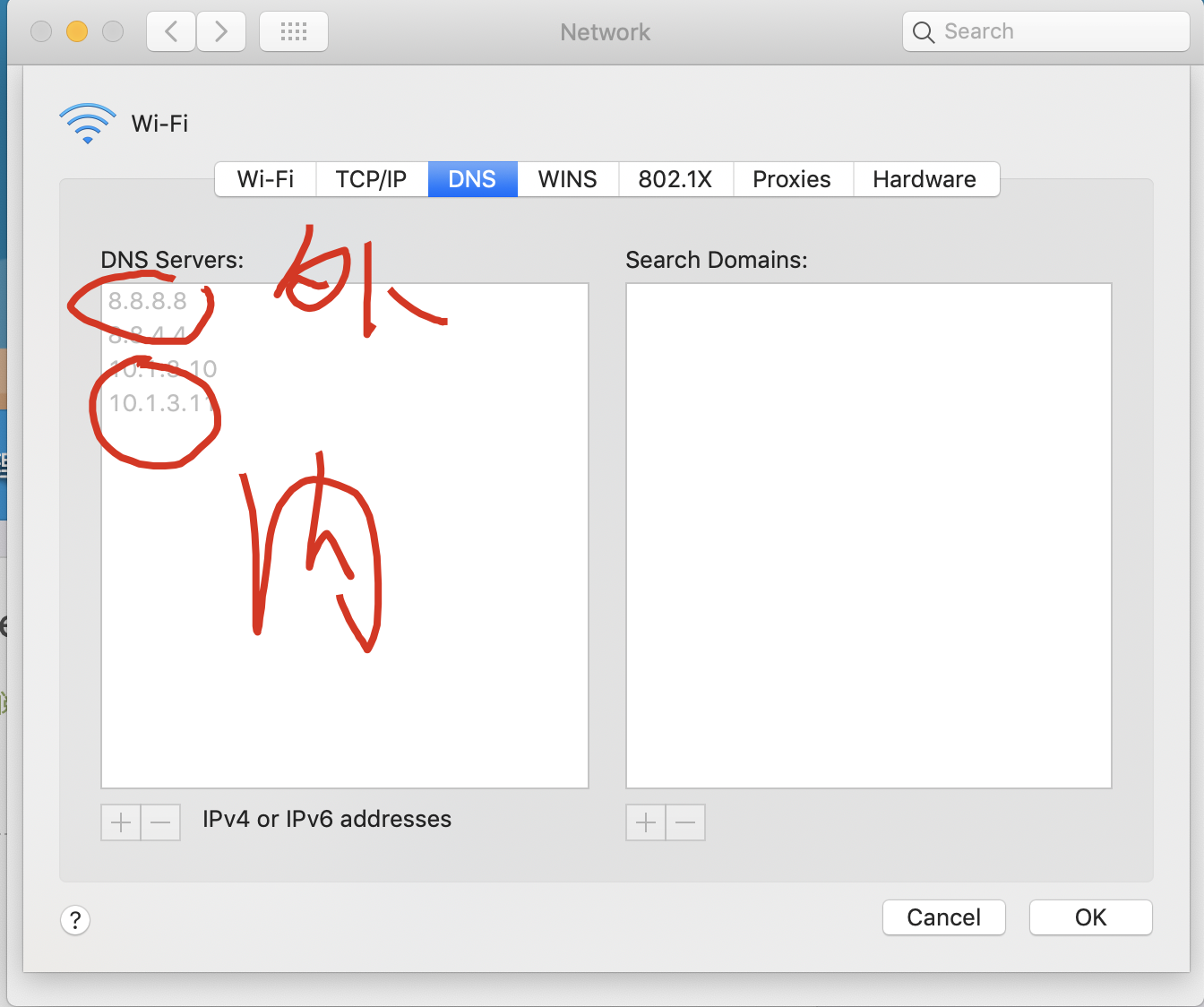DNS_PROBE_FINISHED_NXDOMAIN & MacOS
DNS_PROBE_FINISHED_NXDOMAIN
内网 DNS bug



8.8.8.8
8.8.4.4
# new inner Wi-Fi
10.1.3.10
10.1.3.13
Windows
https://www.wiknix.com/how-to-fix-dns_probe_finished_nxdomain-in-chrome/
MacOS
DNS 刷新
https://www.apple.com/cn/search/DNS?src=globalnav
https://www.apple.com/cn/search/DNS-刷新?src=serp

https://blog.csdn.net/u013356066/article/details/52162889
https://blog.csdn.net/zhaoxiaoruiR/article/details/82459788
https://jingyan.baidu.com/article/154b4631aa51bb28ca8f4114.html
https://www.lifewire.com/network-preference-pane-change-macs-dns-settings-2260394
https://beebom.com/dns_probe_finished_nxdomain-error-fix/
刷新 DNS 命令
http://osxdaily.com/2017/03/08/clear-dns-cache-macos-sierra/
$ sudo killall -HUP mDNSResponder; say DNS cache has been flushed
$ sudo killall -HUP mDNSResponder
$ sudo discoveryutil mdnsflushcache
$ sudo discoveryutil udnsflushcache

// DNS
8.8.8.8
8.8.4.4
ns-lookup
NSLOOKUP(1) BIND9 NSLOOKUP(1)
NAME
nslookup - query Internet name servers interactively
SYNOPSIS
nslookup [-option] [name | -] [server]
DESCRIPTION
Nslookup is a program to query Internet domain name servers. Nslookup
has two modes: interactive and non-interactive. Interactive mode allows
the user to query name servers for information about various hosts and
domains or to print a list of hosts in a domain. Non-interactive mode
is used to print just the name and requested information for a host or
domain.
ARGUMENTS
Interactive mode is entered in the following cases:
1. when no arguments are given (the default name server will be used)
2. when the first argument is a hyphen (-) and the second argument is
the host name or Internet address of a name server.
Non-interactive mode is used when the name or Internet address of the
host to be looked up is given as the first argument. The optional
second argument specifies the host name or address of a name server.
Options can also be specified on the command line if they precede the
arguments and are prefixed with a hyphen. For example, to change the
default query type to host information, and the initial timeout to 10
seconds, type:
nslookup -query=hinfo -timeout=10
The -version option causes nslookup to print the version number and
immediately exits.
INTERACTIVE COMMANDS
host [server]
Look up information for host using the current default server or
using server, if specified. If host is an Internet address and the
query type is A or PTR, the name of the host is returned. If host
is a name and does not have a trailing period, the search list is
used to qualify the name.
To look up a host not in the current domain, append a period to the
name.
server domain
lserver domain
Change the default server to domain; lserver uses the initial
server to look up information about domain, while server uses the
current default server. If an authoritative answer can't be found,
the names of servers that might have the answer are returned.
root
not implemented
finger
not implemented
ls
not implemented
view
not implemented
help
not implemented
?
not implemented
exit
Exits the program.
set keyword[=value]
This command is used to change state information that affects the
lookups. Valid keywords are:
all
Prints the current values of the frequently used options to
set. Information about the current default server and host is
also printed.
class=value
Change the query class to one of:
IN
the Internet class
CH
the Chaos class
HS
the Hesiod class
ANY
wildcard
The class specifies the protocol group of the information.
(Default = IN; abbreviation = cl)
[no]debug
Turn on or off the display of the full response packet and any
intermediate response packets when searching.
(Default = nodebug; abbreviation = [no]deb)
[no]d2
Turn debugging mode on or off. This displays more about what
nslookup is doing.
(Default = nod2)
domain=name
Sets the search list to name.
[no]search
If the lookup request contains at least one period but doesn't
end with a trailing period, append the domain names in the
domain search list to the request until an answer is received.
(Default = search)
port=value
Change the default TCP/UDP name server port to value.
(Default = 53; abbreviation = po)
querytype=value
type=value
Change the type of the information query.
(Default = A; abbreviations = q, ty)
[no]recurse
Tell the name server to query other servers if it does not have
the information.
(Default = recurse; abbreviation = [no]rec)
ndots=number
Set the number of dots (label separators) in a domain that will
disable searching. Absolute names always stop searching.
retry=number
Set the number of retries to number.
timeout=number
Change the initial timeout interval for waiting for a reply to
number seconds.
[no]vc
Always use a virtual circuit when sending requests to the
server.
(Default = novc)
[no]fail
Try the next nameserver if a nameserver responds with SERVFAIL
or a referral (nofail) or terminate query (fail) on such a
response.
(Default = nofail)
RETURN VALUES
nslookup returns with an exit status of 1 if any query failed, and 0
otherwise.
macOS NOTICE
The nslookup command does not use the host name and address resolution
or the DNS query routing mechanisms used by other processes running on
macOS. The results of name or address queries printed by nslookup may
differ from those found by other processes that use the macOS native
name and address resolution mechanisms. The results of DNS queries may
also differ from queries that use the macOS DNS routing library.
FILES
/etc/resolv.conf
SEE ALSO
dig(1), host(1), named(8).
AUTHOR
Internet Systems Consortium, Inc.
COPYRIGHT
Copyright (C) 2004-2007, 2010, 2013-2016 Internet Systems Consortium,
Inc. ("ISC")
ISC 2018-05-25 NSLOOKUP(1)
[Process completed]
```·
## 外网 + 内网
本文首发于博客园,作者:xgqfrms,原文链接:https://www.cnblogs.com/xgqfrms/p/10642852.html
未经授权禁止转载,违者必究!



【推荐】国内首个AI IDE,深度理解中文开发场景,立即下载体验Trae
【推荐】编程新体验,更懂你的AI,立即体验豆包MarsCode编程助手
【推荐】抖音旗下AI助手豆包,你的智能百科全书,全免费不限次数
【推荐】轻量又高性能的 SSH 工具 IShell:AI 加持,快人一步
· AI与.NET技术实操系列(二):开始使用ML.NET
· 记一次.NET内存居高不下排查解决与启示
· 探究高空视频全景AR技术的实现原理
· 理解Rust引用及其生命周期标识(上)
· 浏览器原生「磁吸」效果!Anchor Positioning 锚点定位神器解析
· DeepSeek 开源周回顾「GitHub 热点速览」
· 记一次.NET内存居高不下排查解决与启示
· 物流快递公司核心技术能力-地址解析分单基础技术分享
· .NET 10首个预览版发布:重大改进与新特性概览!
· .NET10 - 预览版1新功能体验(一)
2016-04-02 How to fix locked SD card All In One
2016-04-02 Centos 7 环境下,如何使用 Apache 实现 SSL 虚拟主机 双向认证 的详细教程:
2016-04-02 VI & VIM 使用教程:命令详解大全 & 图解 VI & VIM All In One
2016-04-02 Linux 命令详解教程:cp/mv/rm 对文件和文件夹进行复制、移动(重命名)、删除 All In One